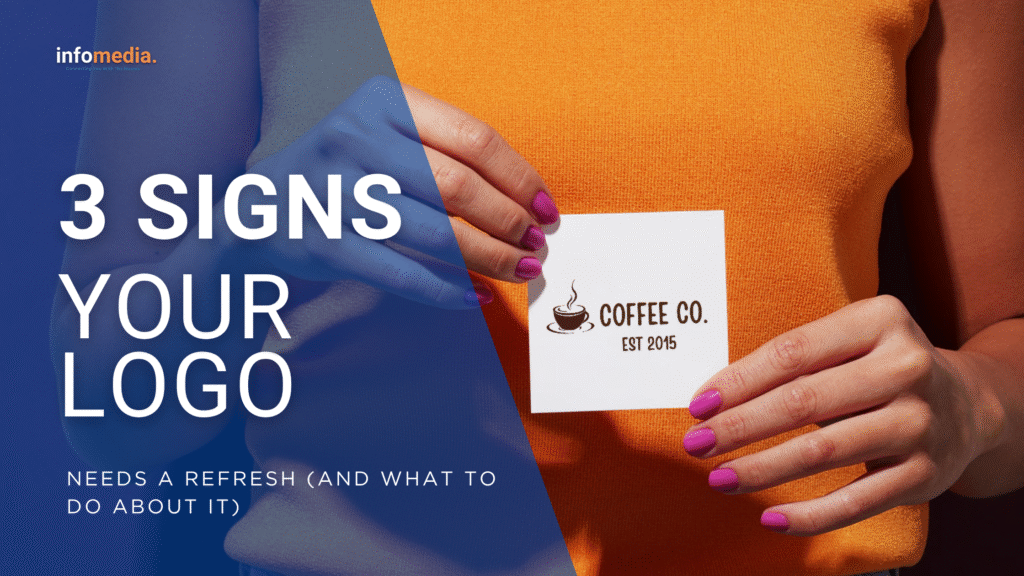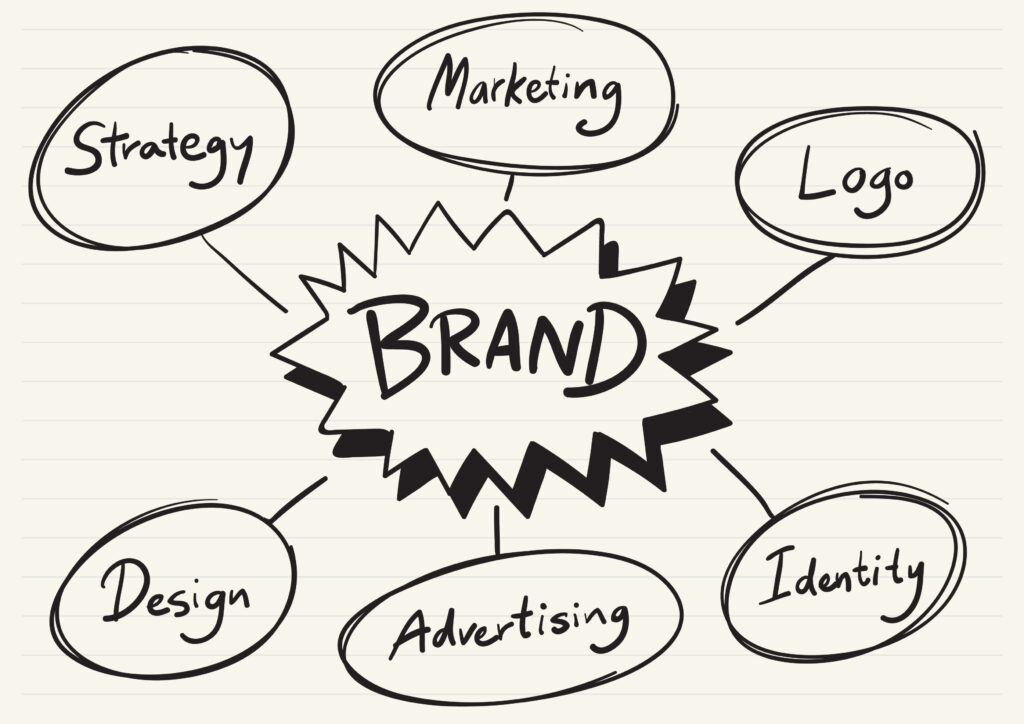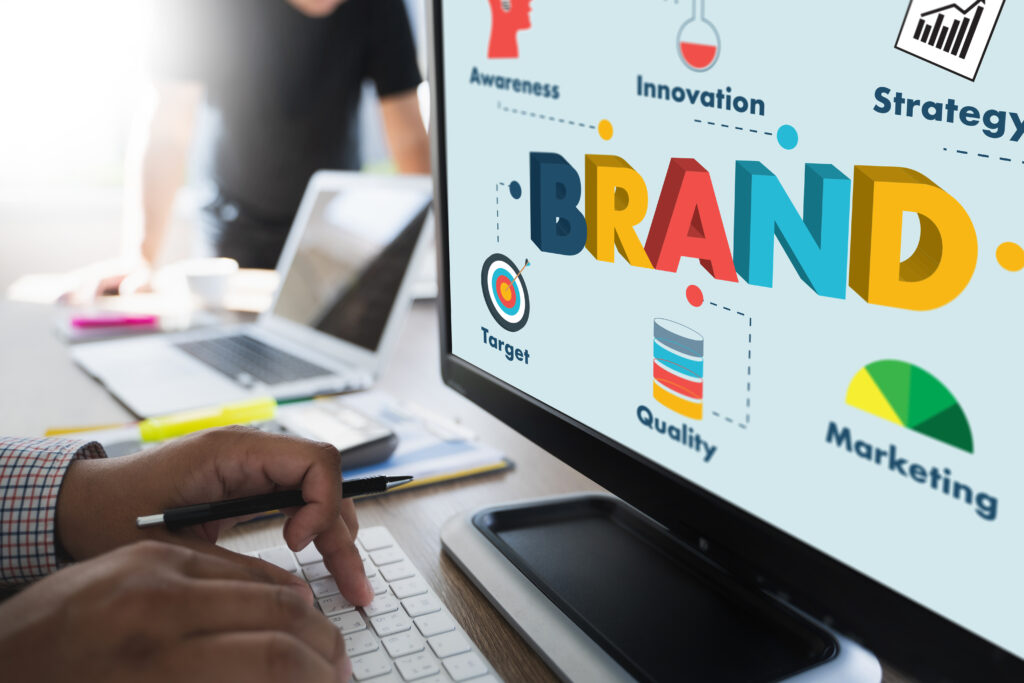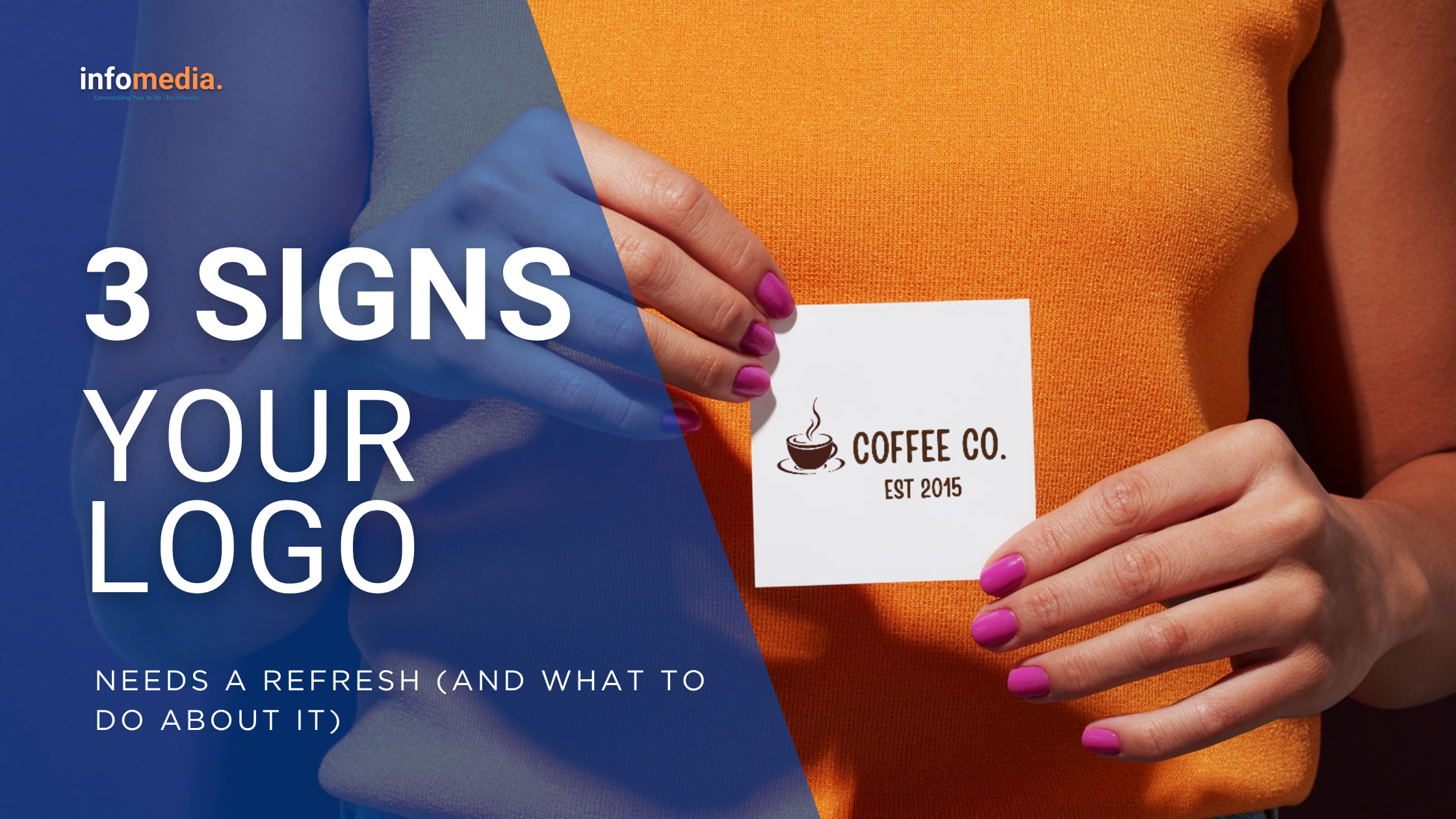How to Choose the Perfect Brand Colours for Your Business

Colour is far more than visual decoration—it’s a silent storyteller that shapes how customers perceive, remember, and interact with your brand. Research shows colour increases brand recognition by up to
3 Signs Your Logo Needs a Refresh (And What to Do About It)

Your logo is often the first thing people see, and the last thing they remember.But over time, even the best designs can lose their edge. Whether it’s poor visibility on signage, an outdated font, or colors that no longer match your vision, your logo might be sending the wrong message. Here are 3 clear signs it’s time to refresh your logo, and how INFOMedia can help you do it right. 1. Your Logo Doesn’t Scale Well If your logo looks crisp on your phone but pixelated on a banner or website, it’s a scaling issue.This usually means your logo was designed in the wrong format or lacks vector quality. A professional refresh ensures it stays sharp across every platform, from business cards to billboards. INFOMedia Tip: Always request your logo in multiple formats (PNG, SVG, PDF, EPS). We provide all of them with every redesign. 2. It No Longer Reflects Your Brand Maybe you started your business years ago, and your style or services evolved, but your logo stayed the same.If your logo doesn’t represent who you are today, customers can get confused or fail to take you seriously. INFOMedia Tip: A small update (color palette, typography, layout) can modernize your brand without losing your identity. 3. You’re Embarrassed to Share It If you hesitate to print your logo on packaging or signage because it doesn’t look “professional enough,” that’s your biggest sign to rebrand.Your brand should make you proud, not cautious. INFOMedia Tip: A rebrand doesn’t have to be expensive. It’s an investment that pays off every time someone recognizes your brand with confidence. Your logo is more than an image, it’s your business identity.When done right, it builds credibility, communicates your values, and leaves a lasting impression. If you’ve spotted any of these signs, let’s talk about giving your business the fresh, professional look it deserves. When you book any branding package this week. Get a FREE logo mockup Contact INFOMedia Today or DM us on Instagram to start your rebrand. Book Now
In Business, It’s the Little Things That Matter – Top 8 “little things” that make a big difference

Success isn’t always about the biggest marketing budget or the fanciest office space. More often than not, it’s the little things that build trust, win clients, and keep customers coming back. We believe that professionalism is not complicated—and in most cases, it doesn’t even require money. Professionalism is about how you show up, not how much you spend. It’s about consistency, reliability, and respect for the people who trust you with their business. Here are some “little things” that make a big difference: 1. Reliability is Everything A reliable business is a respected business. When you make a promise to a customer—whether it’s a delivery date, a callback, or a quote—keep it. If there’s a delay, let them know before they have to ask. Reliability builds trust, and trust builds loyal clients. 2. Don’t Leave Customers on Read One of the easiest ways to frustrate a client is to ignore their messages. Even if you don’t have an immediate answer, acknowledge them. A simple “Got your message, I’ll get back to you by tomorrow” shows that you value their time and concerns. 3. Timely Responses In business, time is currency. Quick, professional responses can be the difference between winning and losing a client. Slow communication sends the message that you don’t prioritize them—fast communication shows you care. 4. Professional Email Addresses A branded email (e.g., name@yourcompany.com) instantly elevates your image. It shows that you’re serious about your business and separates you from spam or casual personal accounts. Infomedia assists with domain hosting from as little as R39 per month. 5. Your Logo is Your Face On WhatsApp, email signatures, and social platforms, your logo is often the first thing people see. Using it consistently creates a professional, trustworthy image and strengthens your brand identity. 6. Use WhatsApp Business It’s free, easy to set up, and adds a layer of professionalism. You can set business hours, automated replies, and showcase your products or services—while keeping your personal and business life separate. 7. Keep Customers Updated Don’t leave clients wondering about the status of their project. Send updates, even if the update is “We’re still on track.” It keeps them confident in your service and reduces unnecessary follow-ups. 8. Be Trustworthy & Fair Honesty isn’t a marketing gimmick—it’s the foundation of long-term business relationships. Deliver what you promise, charge fairly, and treat clients as partners, not transactions. We’ve learned that these small habits, done consistently, have a bigger impact than expensive advertising campaigns. Clients remember how you made them feel, and professionalism—simple, genuine, and consistent—makes them feel valued. Because in business, it’s the little things that matter… and the little things are often free.
Why You Should Wear Your Brand Everywhere You Go

7 Branding Mistakes Killing Your First Impressions (And How to Fix Them)

Your brand’s first impression can be the deciding factor between “Tell me more!” and “Thanks, but no thanks.” Whether you’re a scrappy startup or an established SME, avoiding these seven common pitfalls will set you on the path to a stronger, more memorable brand. And remember: every misstep is an opportunity to learn—and to shine brighter than before. 1. Treating Your Logo as Your Brand The mistake: Thinking a great logo alone will carry all your brand messaging.Why it hurts: A logo is just one piece of a much larger puzzle. If your messaging, tone of voice, customer experience, and visual identity don’t align, you create confusion rather than clarity.How to fix it: 2. Overlooking Readability and Legibility The mistake: Choosing fancy fonts or tiny text to “stand out.”Why it hurts: If people struggle to read your headline or menu, they’ll bounce before they even notice your message.How to fix it: 3. Ignoring Your Ideal Customer The mistake: Crafting generic messaging intended to “appeal to everyone.”Why it hurts: A diluted brand voice fails to resonate. Potential customers quickly sense when you’re not speaking directly to their needs.How to fix it: 4. Clashing or Inconsistent Color Palettes The mistake: Using every color under the sun because you “can’t decide.”Why it hurts: A chaotic color scheme looks unprofessional and undermines brand recognition.How to fix it: 5. Neglecting Your Online Presence The mistake: Assuming “print does it all” or “social media is just optional.”Why it hurts: In 2025, customers expect a seamless omni-channel experience. A disjointed presence dilutes trust.How to fix it: 6. Focusing Only on Acquisition, Not Retention The mistake: Pouring all your energy (and budget) into finding new leads, while forgetting about the customers you already have.Why it hurts: Acquiring a new customer costs up to five times more than retaining an existing one—and repeat customers spend more over time.How to fix it: 7. Being Afraid to Evolve The mistake: Clinging too long to outdated designs, messaging, or service offerings because “that’s how it’s always been done.”Why it hurts: Markets, trends, and customer expectations shift—and brands that don’t adapt look stale, or worse, irrelevant.How to fix it: Keep Moving Forward—Your Brand Deserves It Making these seven branding mistakes? You’re not alone. The good news is that identifying and fixing them can boost your credibility, amplify your reach, and deepen customer loyalty. Your next step: Pick one area above that resonates most—maybe your color palette feels off, or perhaps you know your messaging is too generic. Commit to one small change this week. And if you ever need a partner to guide you through the process—whether it’s creating a consistent style guide, printing eye-catching signage, or executing a full brand refresh—Infomedia is here to help. Let’s turn those first impressions into lasting relationships. Ready to elevate your brand? Reach out to Infomedia today for a free consultation and see how an integrated approach to branding, digital marketing, and printing can transform your business. Remember: a positive, proactive brand is a powerful brand. Start small, stay consistent, and watch your audience—and your confidence—grow.
6 Ways to Make It Easier for Customers to Do Business with You

Ever lost a sale not because your product wasn’t good, but because the process was just… too complicated? The truth is, people don’t just buy your service—they buy the experience of doing business with you. At Infomedia, we’ve learned that one of the best forms of marketing isn’t shouting louder, it’s making it easier. Here’s how you can do the same: 1. Be Where People Are Don’t make people hunt you down. If your audience lives on WhatsApp, Facebook, Instagram or email—be there. Having multiple, active communication channels increases your reach and removes friction. At Infomedia, whether someone slides into our DMs or sends a formal request via email, we respond quickly and consistently. 2. Clear, Accessible Information Your business shouldn’t feel like a scavenger hunt. Prices, packages, turnaround times, product specs, payment details—make them easy to find. Whether it’s on your website, quote, or invoice, the information must be clear and consistent. Confusion leads to cart abandonment or people giving up mid-process. 3. Streamline the Process From enquiry to payment to delivery—simplify every step. Have ready-to-send documents, pre-designed forms, standard terms and conditions, and clear payment links. The fewer times a client has to ask, “So what’s next?”, the better your business looks. 4. Offer Flexible, Modern Payment Options Make paying the easiest part. EFT, card payments, SnapScan, PayFast—whatever fits your client base. People are more likely to confirm orders when payment is instant and secure. A customer shouldn’t have to ask if you accept cards in 2025. 5. Stay Human Auto-responses are fine, but nothing beats clear, friendly, human communication. Speak your client’s language. Don’t bombard them with jargon. Let them feel heard. The client who feels understood is the one who returns—and refers. 6. Consistency Builds Trust If you say turnaround time is 5 working days—deliver in 5. If there’s a delay, communicate early. Consistency isn’t perfection, it’s reliability. That’s what keeps businesses alive. Final ThoughtEvery business wants more sales. But it’s not always about lowering prices or doing fancy ads. Sometimes, it’s as simple as making it easier for people to say yes to you. At Infomedia, we don’t just build brands and print signs—we build experiences that make doing business smoother, faster, and more enjoyable. Because when it’s easy to work with you, people want to.
2026 Branding Trends That Will Define the Next Era of Business

As brands evolve alongside technology and shifting consumer values, 2026 promises to bring a new wave of branding approaches that prioritize genuine connections, purpose-driven narratives, and immersive experiences. Below are the top trends shaping the future of branding this year. 1. Purpose-First Brand IdentitiesConsumers expect brands to stand for more than profits—they demand clarity about a company’s mission and societal impact. In 2026, successful brands will integrate their social, environmental, or ethical purpose into every touchpoint. This means embedding sustainability into product design, supporting community initiatives in real time, and transparently reporting progress toward goals. Purpose-first branding transforms corporate responsibility from a marketing tactic into the very DNA of a brand. 2. Dynamic Brand SystemsGone are the days of rigid logos and static style guides. Modern brands embrace dynamic systems—flexible visual identities that adapt to context, audience, or platform. A logo might shift color or form based on user location, a campaign theme, or even the time of day. This fluidity keeps a brand feeling fresh and responsive, while still grounded in a consistent core identity. 3. Co‑Creation and Community-Driven InnovationBrands are no longer sole proprietors of their narratives; they’re collaborators with their communities. In 2026, co‑creation will take center stage as brands invite customers, influencers, and even competitors to shape product features, packaging designs, and campaign ideas. Crowdsourced branding initiatives foster ownership, drive engagement, and ensure that offerings resonate deeply with target audiences. 4. Sensory Branding Beyond SightVisual identity remains essential, but leading brands are expanding into multisensory experiences. Sound logos, ambient scents in retail spaces, and tactile packaging materials create stronger emotional associations and memorable encounters. As digital-physical boundaries blur, brands that orchestrate sight, sound, smell, and touch in harmony will stand out in a crowded marketplace. 5. Micro‑Moment StorytellingAttention spans are shorter than ever, and brands must captivate audiences in fleeting “micro‑moments”—those instances when consumers turn to devices for quick answers or inspiration. In 2026 branding, this means crafting ultra‑concise narratives: snappy animated logos, bite‑sized social posts that convey brand ethos, and interactive web features that tell a story in seconds. The art lies in conveying authenticity in minimal time. 6. Data-Infused Emotional BrandingBrands are using AI-driven analytics not just to predict buying behavior but to understand the emotional journey of their customers. By mapping sentiment shifts across touchpoints—website visits, social comments, customer support interactions—brands can tailor messaging that resonates on a human level. This fusion of data and empathy elevates branding from transactional to transformational. 7. Hyper‑Localized Brand ExpressionsWhile global consistency remains important, top brands are embracing localized sub‑brands or “brand flavors” that reflect regional cultures, languages, and trends. These micro‑brands operate under a unified umbrella but speak directly to local sensibilities—whether through dialect‑specific copy, regionally inspired visuals, or partnerships with neighborhood artists. This hyper‑local approach fosters deeper loyalty and relevance. 8. Ethical Transparency as a Brand PillarTransparency is not optional; it’s the foundation of trust. In 2026, brands will proactively share not only their successes but also their challenges—supply chain hiccups, labor issues, or environmental setbacks—and outline concrete plans for improvement. Real‑time dashboards, blockchain‑verified provenance, and open Q&A sessions will demystify processes and solidify brand credibility. 9. Mixed‑Reality Brand ExperiencesAugmented and virtual reality technologies have matured to the point where brands can offer immersive world‑building experiences. From virtual flagship stores to AR‑powered packaging that unlocks behind‑the‑scenes content, mixed reality brings brand stories to life in three dimensions. As devices become more accessible, these experiential touchpoints will move from novelty to necessity. 10. Brand Humanization Through Internal StorytellingPerhaps the most enduring trend of 2026 is the continued humanization of brands via their own people. Brands are turning their employees into brand ambassadors by showcasing authentic workplace stories, celebrating individual contributions, and highlighting diverse voices across leadership teams. This internal storytelling fosters a culture of transparency and invites customers into the brand’s human side.
The New Rules of Social Media Management for Brands That Want Results (Not Just Likes)

Why Your Website Is Leaking Sales (And What to Do About It in 2025)

How E-Commerce Automation is Saving Companies Hundreds of Hours — And How to Implement It Right
















